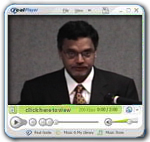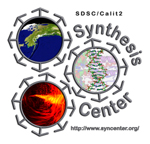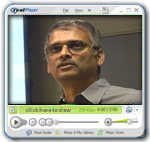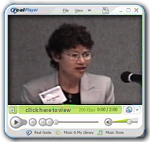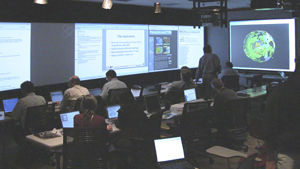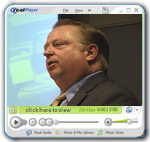SDSC and Calit2 Open Synthesis Center
|
Center Creates an Interactive Environment for Scientists and
Engineers to Collaborate and Develop Cyberinfrastructure Tools
San Diego, CA, May 23, 2005 -- The San Diego Supercomputer Center (SDSC) and the California Institute for Telecommunications and Information Technology (Calit2), both at the University of California, San Diego (UCSD), today announced the opening of the SDSC/Calit2 Synthesis Center. Located on the first floor of the SDSC building, the center's tools and user services are designed to bring together scientists from different disciplines with information technology experts, offering users access to the existing and new cyberinfrastructure tools needed to solve multidisciplinary and multi-science problems in a collaborative way.
The center launched today with a grand opening featuring a welcome address from UCSD Chancellor Marye Anne Fox, followed by comments
|
from SDSC director Fran Berman, Calit2's UCSD Division director Ramesh Rao, and Synthesis Center director Chaitan Baru. Following the presentations, attendees toured the center and attended demonstrations from a variety of scientists who will be utilizing the center's tools.
|
"Science is becoming a team effort," said Marye Anne Fox, UCSD Chancellor. "The complex, collaborative ventures that are demonstrated here today, and many others like them, will be the heart of the SDSC/Calit2 Synthesis Center."
"The Synthesis Center helps today's scientists and engineers develop a 'personal cyberinfrastructure' that allows them to configure the relevant, data, computational, software, network, visualization, human and other resources to achieve project goals," said SDSC director Berman. "The center integrates SDSC's comprehensive data cyberinfrastructure resources
|
and Calit2's great expertise and environment to enable new advances and discoveries. SDSC and Calit2 are a great team and we are delighted to be able to work together to help the research and education community move ahead."
"Our researchers are tackling problems that involve ever-growing volumes of data from an expanding variety of heterogeneous sources and platforms, and often the only way to gain insight from large data sets is to synthesize the information," said Calit2's Rao. "From its inception, Calit2 has invested heavily in immersive visualization rooms, and the Synthesis Center goes one step further by integrating visualization with data mining, data analysis, and easy access to storage and computing clusters. Taken together, these tools give scientists and engineers what they need to work on vast and disparate data sets with other scientists, whether they're in the center, in Calit2's new headquarters across the UCSD campus, or at research facilities half-way around the world." The Calit2 building, now nearing completion, is set to open in October 2005, and will include companion facilities linked to the Synthesis Center via ultra-high-speed optical networking.
|
"The push over the next decade will be in synthesizing information from a variety of disciplines and models to understand complex phenomena," said Synthesis Center director Baru. "The goal of the center is to bring together information technology and science to support inter-disciplinary science in a collaborative, face-to-face setting with advanced visualization capabilities. There, scientists will be able to take on complex scientific endeavors in a variety of disciplines such as ecological change and its effects at the continental scale, active tectonics, California water resources and homeland security issues."
Users can utilize the Synthesis Center in three different ways: setting up experiments, running experiments, and analyzing results. During the preparation phase, users reserve the center for activities such as examining, understanding and cleaning databases in preparation for the experimental phase. Once the databases have been assembled and the tools are ready, researchers can use the Synthesis Center to perform
|
computational 'runs'. These runs can take hours, days or even weeks. Lastly, users can use the Synthesis Center to review, evaluate and store the massive amount of data typically generated with each run. In addition, visualization services are available on an on-demand basis.
As the nexus of SDSC's visualization department, the Synthesis Center offers a unique environment with large-scale, wall-sized displays linked to powerful on-demand cluster computing systems, all with easy access to storage and important databases. In addition to the visualization component, the center offers data analysis and mining tools that allow users to store data locally and/or make that data available via high-speed networks.
The center can be scheduled for several days or weeks at a time for scientists to meet and discuss science in real time with access to on-demand computing. Between such sessions, center staff work with domain and computer scientists to assemble the data, tools and systems needed in preparation for the next session.
About SDSC
SDSC is a world leader in using, innovating and providing information technology to enable advances and new discovery in science and engineering. Focusing on data-oriented and computational science and engineering applications, SDSC serves as an international resource for data cyberinfrastructure through the provision of software, hardware and human resources in multi-disciplinary science and engineering, and serves as a leadership national cyberinfrastructure Center to the National Science Foundation (NSF) and broader community. SDSC is an organized research unit of the University of California, San Diego with a professional staff of interdisciplinary scientists and engineers, software developers, service and support personnel. SDSC collaborates widely with national and international partners, federal agencies, private industry and others.
About Calit2
The California Institute for Telecommunications and Information Technology is one of four institutes funded through the California Institutes for Science and Innovation initiative. Created in late 2000, the institutes aim to ensure that California maintain its leadership in cutting-edge technologies. The mission of Calit2 is to extend the reach of the current information infrastructure throughout the physical world - enabling anywhere/anytime access to the Internet. More than 200 professors and senior researchers from UC Irvine and UC San Diego are collaborating on interdisciplinary projects with funding from roughly 50 industry partners.
Related Links
SDSC/Calit2 Synthesis Center
SDSC Data Central
Jacobs School of Engineering
Media Contacts
Media Contacts: Ashley Wood, (858) 534-8363, awood@sdsc.edu or Doug Ramsey, (858) 822-5825, dramsey@ucsd.edu

